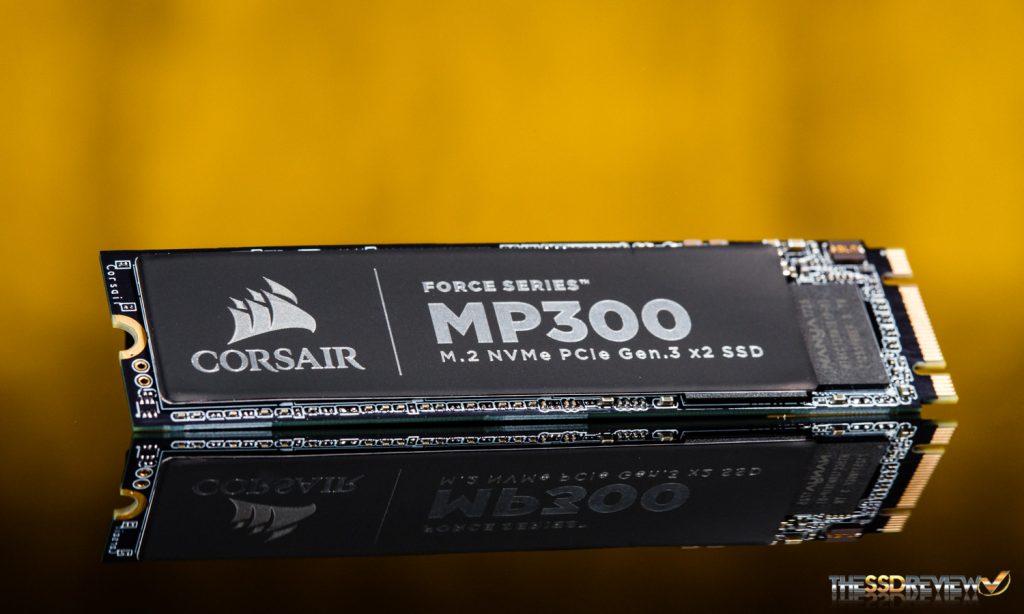Corsair has SSD options for almost any need in the market. Want an entry-level SATA based SSD? The Force LE has you covered. Need high performance? You can choose from the Neutron NX500 or Force MP500 depending on the form factor and capacity that works best for you. Now, we have a new addition for those looking for something in between, the Force MP300. It features a black PCB, copper sticker label, and a PCIe 3.0 NVMe interface, it’s essentially the MP500’s baby brother. Like the E7 powered MP500, the new MP300 features a 5-years warranty, but unlike the MP500, it isn’t out to set any speed records.
The key differentiators here are that the MP300 is powered by a Phison E8 controller that is paired with the latest BiCS3 TLC NAND from Toshiba. The Phison E8 controller utilizes a PCIe 3.0 x2 interface, half the lanes the E7 controller uses. This makes for less available bandwidth and impacts sequential performance, but in turn, it helps to improve power efficiency and keep controller development costs down, which means cheaper prices for the end product.
Based on hardware and performance specs, the MP300 is to compete with the likes of other entry-level NVMe storage devices such as the MyDigitalSSD SBX, Kingston A1000, ADATA GAMMIX S10, Toshiba OCZ RC100 and now, Intel 660p to name a few. These products are poised as step up from SATA SSDs, drives to help accelerate NVMe SSD adoption. They offer consumers a little more performance without forcing them to spend an extra $50-100 on enthusiast class product.
But, is that the case for the Corsair Force MP300? After all, Corsair has always been a premium brand with premium prices and over the past two months, prices for all SSDs have been crashing down. Will Corsair’s brand loyalty and the MP300’s price and performance be enough to sway consumers their way when most only care if the drive is cheap and good enough? Read on to find out our thoughts and decide for yourself.
SPECIFICATIONS
The Corsair Force MP300 is a PCIe 3.0 x2 NVMe SSD. It communicates with the host via the NVMe 1.2 protocol and comes in an M.2 2280 form factor. Listed on Corsair’s website, we can see that it is available in capacities of 120GB ($49.99), 240GB ($69.99), 480GB ($134.99), and 960GB ($264.99).
Because of its link limitation of just two PCIe 3.0 lanes, it provides sequential speeds of up to 1.6GB/s read and 1,080MB/s write for the 960GB model. The lower capacities feature lesser read and write speeds. The 240GB model we are reviewing today is rated at 1,580MB/s read and 920MB/s write. As well, the MP300’s 4K random performance is rated for up to 240K/210K IOPS read/write. The 240GB model is rated for 110K/180K read/write.
The MP300 also features an SLC write cache. This means those write speed numbers are the rated performance speeds of the NAND when the workload is hitting the SLC write cache, or a limited LBA range where the TLC acts like SLC NAND. It is a great way to get more performance out of the inherently slower TLC NAND, but once the workload falls out, write performance takes a hit. How much of a hit is disclosed on the last page of the review.
It also boasts advanced error correction and improved data retention to keep data safe. Static and dynamic wear leveling help to increase the reliability and lifespan of the drive. Of course, there is also TRIM support, SMART data reporting, and secure erase support. In addition to this, Corsair even provides and SSD Toolbox which enables you to monitor the drive over its service life, update the firmware, clone over your system, and more. If that wasn’t enough, Corsair backs the Force MP300 with a 5-year warranty.
A CLOSER LOOK
The MP300’s packaging is identical to that of the MP500 we reviewed back in February of last year. It has a premium blacked out theme that we like. All the important tech specs on the front as well as compliances listed on the back.
Like Corsairs MP500 line up, the MP300 features a beautiful blacked out PCB and is thermally optimized. This means that the MP300 label that resides over the components is made of a copper that helps to dissipate heat away from them faster than a conventional sticker. Thus, it can withstand higher demand workloads longer without thermally throttling than without.
Tearing off the sticker label, we can see what powers the MP300 at last, a Phison E8 controller. It is paired with a NANYA DRAM cache and some of Toshiba’s latest BiCS3 64-layer 3D TLC NAND flash. Once formatted in Windows we see a total addressable user capacity of 224GB.
 The SSD Review The Worlds Dedicated SSD Education and Review Resource |
The SSD Review The Worlds Dedicated SSD Education and Review Resource | 

